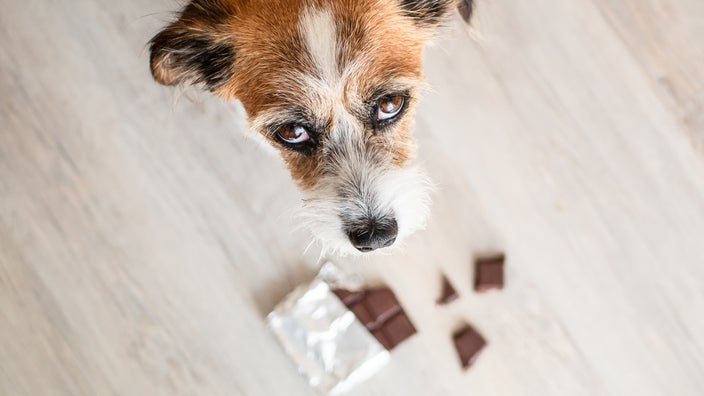
Dogs Cannot Eat Chocolate. Here’s Why It’s Bad for Dogs.
Key takeaways:
Chocolate is dangerous to dogs because of its theobromine, caffeine, fat, and sugar content.
Do not give chocolate of any kind to dogs. It can cause symptoms like vomiting, diarrhea, hyperactivity, and seizures.
If your dog eats chocolate, call a veterinarian or a pet poison hotline immediately.
Table of contents

Many people enjoy chocolate. Unfortunately, dogs love chocolate too. But chocolate is bad for dogs. If your dog eats chocolate, call a vet or a pet poison hotline as soon as possible.
Why is chocolate so bad for dogs? Chocolate comes from the seeds of the fruit that grows on cacao trees. The seeds contain substances that are toxic to dogs. In addition, chocolate contains fats and sugar that are also bad for dogs.
Let’s look at why you’ll want to keep chocolate far away from your precious pup.
Search and compare options
Which ingredients in chocolate are bad for dogs?
Four components (or ingredients) in chocolate contribute to toxicity in dogs:
Theobromine
Caffeine
Fat
Sugar
Theobromine and caffeine are toxic for dogs. Dogs can’t digest either theobromine or caffeine well, so they are highly sensitive to their effects. Theobromine seems to be the more dangerous of the two. It takes much longer for it to leave the body than caffeine. But both substances can affect a dog’s heart, kidneys, and central nervous system. Unexpected increases in fat and sugar can also cause stomach upset in dogs.
Are all types of chocolate bad for dogs?
Toxicity depends on the type of chocolate, how much your dog ate, and your dog’s size. Individual sensitivity can also play a role. As a rule of thumb, the darker the chocolate, the more toxic it is for your dog. But let’s take a closer look at the different types of chocolate.
Dark chocolate
The darker the chocolate, the more theobromine and caffeine it contains. This means it takes less dark chocolate to cause a problem for your dog.
Milk chocolate
Milk chocolate is a combination of chocolate liquor and lecithin, vanilla, or milk solids. As a result, it doesn’t contain as much theobromine as dark chocolate. But it’s still toxic to dogs, and they should never eat it.
Bookmark these hotlines: If you think your dog ingested something poisonous, calling a pet poison hotline can help save their life. Learn what to expect if you need to call.
Foods poisonous to dogs: Chocolate isn’t the only human food that’s toxic for dogs. Check out this list of foods that dogs should never eat to make sure you know what’s safe and what’s not.
Scented candles and dogs: You may enjoy burning scented candles in your home. But if you’re concerned about their safety around dogs, read this for best practices.
White chocolate
White chocolate doesn’t usually have enough theobromine or caffeine to cause symptoms or illness in dogs. But you still shouldn’t give it to dogs because of the fat and sugar content. As a rule, dogs should not eat any amount of chocolate.
Sugar-free chocolate
Sugar-free chocolate may be even more toxic to dogs because they sometimes contain xylitol, a sugar alcohol used to sweeten many food products. For dogs, even a small amount of xylitol can be lethal.
Consult a veterinarian right away if your dog ingests sugar-free chocolate. If a veterinarian is unavailable, take your dog to an emergency animal hospital or call a pet poison helpline.
Read more like this
Explore these related articles, suggested for readers like you.
Other chocolate products
Other chocolate products that contain very high amounts of theobromine and can cause serious illness for your dog are:
Cocoa beans
Cocoa powder
Baking chocolate
Semisweet chocolate
How much chocolate is toxic to a dog?
Chocolate toxicity for your dog will depend on the amount of theobromine and caffeine in the chocolate and your pup’s weight. Symptoms also vary depending on how much your dog ate. Smaller dogs don’t have to eat as much chocolate as bigger dogs to become ill.
Consuming around 1 oz of milk chocolate per pound could be lethal for dogs. But ingesting even less could be toxic. For a visual, 10 snack-size Hershey’s milk chocolate bars are a little less than 5 oz. If a 60 lb dog ate 10 Hershey’s snack bars, they may not be harmed. But if a 10 lb dog ate the same amount, it’s likely an emergency.
An online chocolate toxicity calculator can help you understand your dog’s risk. You will need to fill in the type of chocolate and about how much your dog consumed and your dog’s weight.
The packages for chocolates typically indicate which type they are. Most usually show the weight of the package somewhere on the bottom corners of the label.
Some pet owners may not know how much chocolate their dog ate. Or their dog may have eaten a mixture of chocolate and chocolate-covered nuts.
But keep in mind, even if you can estimate how much your dog ate, it’s always best to consult a veterinarian.
What are symptoms of chocolate poisoning in dogs?
Chocolate can cause a number of symptoms in your dog. The symptoms may not appear for hours after your dog eats chocolate. Symptoms also vary depending on how much chocolate your dog ate.
Common signs of chocolate toxicity in dogs can include:
Excessive thirst
Restlessness
Bloating
Racing heartbeat or unusual heart rate
Hyperactivity
More severe symptoms of chocolate poisoning include:
Tremors
Heart failure
Collapse
Can chocolate cause pancreatitis in dogs?
The high amount of fat in chocolate can cause pancreatitis in dogs. Pancreatitis is a condition that causes the pancreas to digest itself rather than nutrients from food. Not all dogs will develop pancreatitis, but chocolate will give most an upset stomach.
The symptoms of pancreatitis in dogs include:
Vomiting
Diarrhea
Pain in the abdomen
What to do if your dog eats chocolate
If your dog has eaten chocolate, immediately call a veterinarian or a pet poison hotline. Be prepared to tell them what kind of chocolate your dog ate, about how much they consumed, and your dog’s weight.
The two main pet poison hotlines may charge a consultation fee. They can be reached at:
How do vets treat chocolate poisoning in dogs?
Treatment for chocolate toxicity depends on the type of chocolate your dog ate, how much they ate, and how much time has passed. It can take up to 4 days for the effects of chocolate toxicity to pass.
If you report it early enough, a veterinarian may induce vomiting and give your dog activated charcoal to limit the spread of toxic substances. Do not try to make your dog vomit on your own.
In more severe cases of chocolate poisoning, a veterinarian might put your dog on supportive therapy. This could include:
IV fluids
Medications to treat symptoms
Sedation
The goal is to keep your dog stable and supported until they can work the toxic substances out of their body. Dogs with severe toxicity might have to stay in the hospital for multiple days.
If treatment is started soon after your dog ingests the chocolate, the prognosis for recovery is good. It’s also good for dogs with only mild signs of chocolate poisoning, such as vomiting and diarrhea. Death is rare, but dogs with severe signs, such as seizures, have a lower chance of recovery.
A veterinarian can help you determine how well your dog will do with treatment based on how much chocolate they ingested. If you don’t know the amount, a veterinarian will still be able to help determine their prognosis.
Frequently asked questions
Yes, Nutella is poisonous for dogs. It contains cocoa powder, which has high amounts of theobromine and caffeine. Nutella also contains high fat and sugar. If your dog has eaten Nutella, contact a vet or a pet poison hotline immediately.
No, dogs shouldn’t eat Oreos or other chocolate sandwich cookies. If a dog eats one Oreo, they may not experience any illness or chocolate poisoning. But if they eat multiple Oreos, depending on their age, weight, and preexisting health conditions, they’re likely to experience poisoning symptoms. If your dog has eaten Oreos or other chocolate sandwich cookies, contact a vet or a pet poison hotline.
The bottom line
Chocolate should never be given to dogs. The theobromine and caffeine in chocolate are toxic to dogs. Chocolate toxicity can cause a range of symptoms, from vomiting and diarrhea to hyperactivity and seizures.
If your dog eats chocolate, call a veterinarian or a pet poison hotline immediately. They will help you determine next steps. If you report it early, a vet may induce vomiting and give activated charcoal to your dog to prevent worsening symptoms. Severe cases might need supportive therapy in the form of fluids, medication, or sedation.
Why trust our experts?



References
Brooks, W. (2023). Chocolate toxicity in dogs. Veterinary Partner.
Brooks, W. (2023). Pancreatitis in dogs. Veterinary Partner.
Cohen, A. (n.d.). Chocolate toxicity: What should I do if my dog eats chocolate? Cornell Richard P. Riney Canine Health Center.
Hayes, C. (2024). Chocolate toxicosis in animals. Merck Veterinary Manual.
Nutella. (n.d.). Products: Nutella® jar.
Pet Poison Helpline. (n.d.). My dog ate Oreos, should I be worried?
Schmid, R., et al. (n.d.). Chocolate poisoning in dogs. VCA Animal Hospitals.
U.S. Food and Drug Administration. (2021). Paws off xylitol; it’s dangerous for dogs.
Weingart, C., et al. (2021). Chocolate ingestion in dogs: 156 events (2015–2019). Journal of Small Animal Practice.
Young, A. (2020). Chocolate poisoning in dogs. University of California, Davis, School of Veterinary Medicine.





























